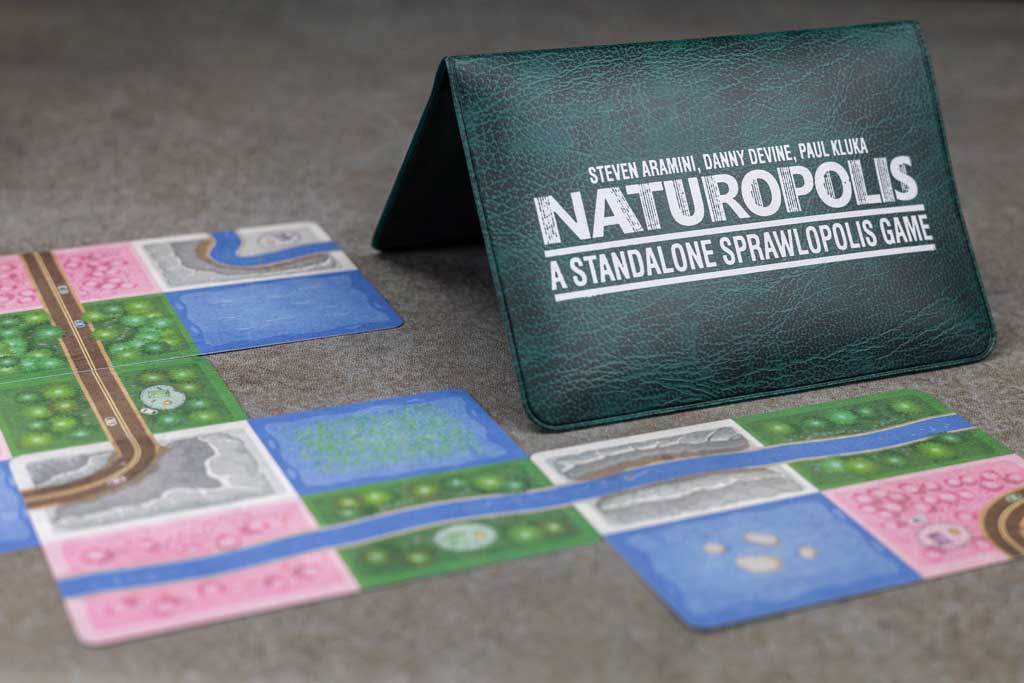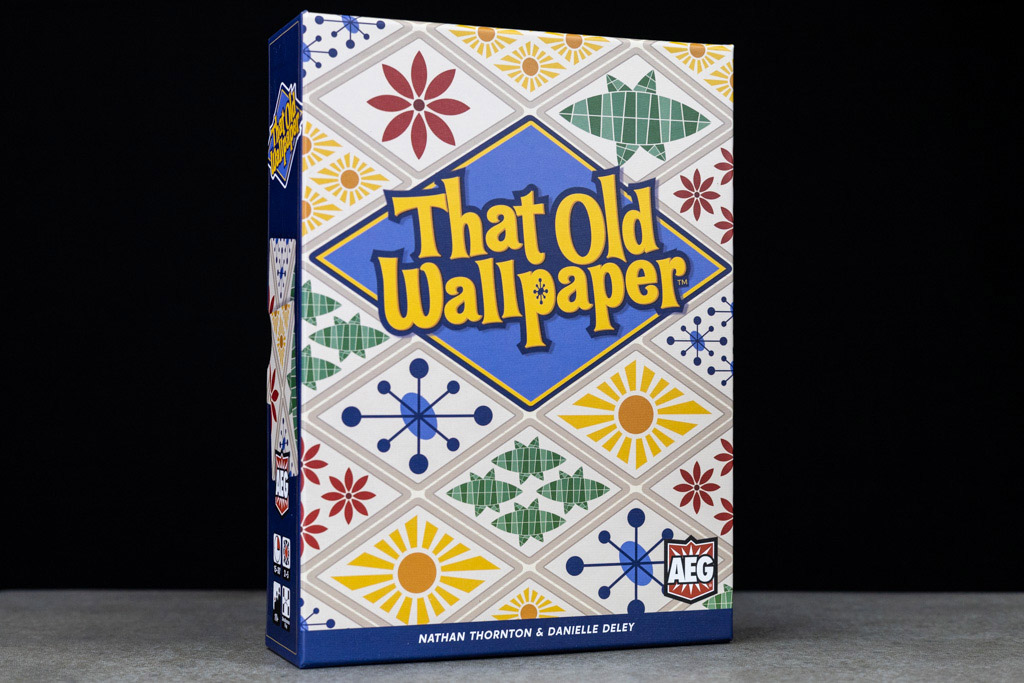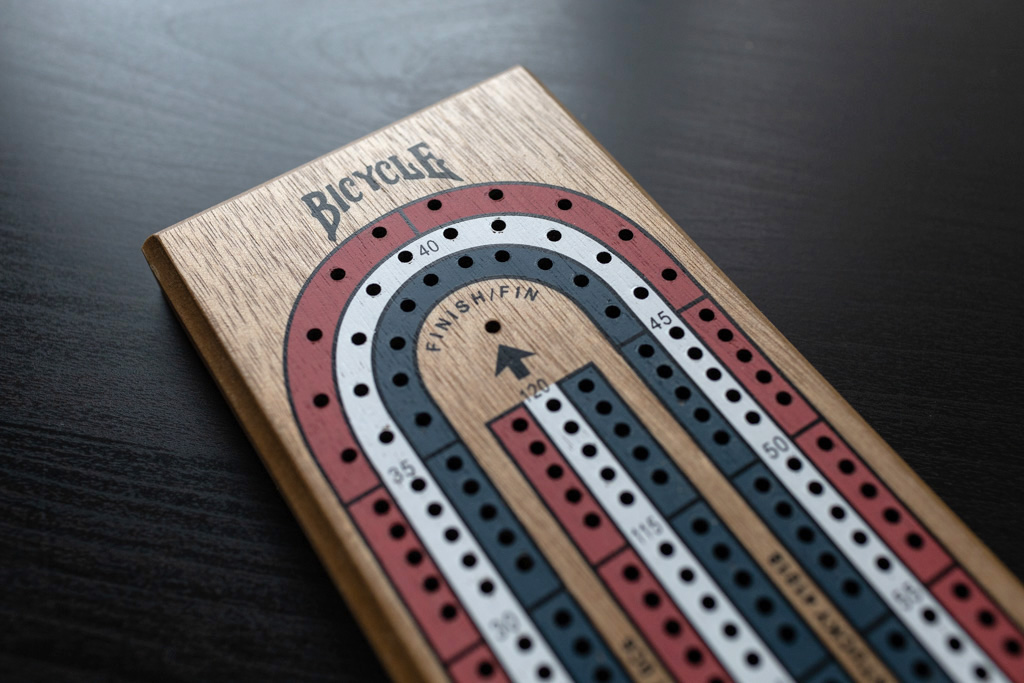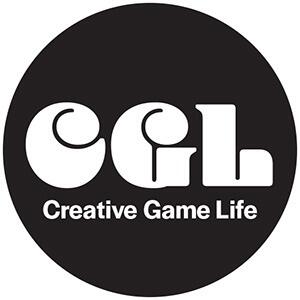
Early into our tabletop adventure we spotted Euphoria on the shelf at our FLGS and chuckled. The deadpan sense of humor and future-retro theme seemed unique sitting on the shelf between all the dragons and Renaissance faces adorning other game boxes. Euphoria seemed like our kind of game and resonated with some of our favorite cultural moments like Terry Gilliam’s Brazil, Aldous Huxley’s Brave New World, and the Fallout series of happy-go-lucky dystopian conquest.
In 2019 we were lucky enough to get out hands on the most recent reprint of Euphoria and eagerly got the game to our table for a series of rounds with friends, as a duo, and sometimes solo learning the rules and mechanics. We found the game to be much more challenging than it first appeared but also very rewarding to learn how the game balances itself and reveals new ways for players to catch up. The game offers multiple paths to success and we found ourselves wanting to play again to find new opportunities. This most recent reprint of Euphoria includes a beautiful set of 3 Game Trayz that make setup and play a lot of fun. For those of you who like to keep game boxes vertical, this one stands on the shelf well.

Euphoria: Build a Better Dystopia an award-winning game designed by Jamey Stegmaier and Alan Stone. It is a worker-placement game designed for 2 to 6 players that takes between 60 to 90 minutes to play. Game components include custom dice as workers, wooden meeples as resources and markers, cards as artifacts and recruits, and tiles as buildings. The story begins in a post-apocalyptic world where society has broken into four allegiance — Euphorian, Wastelander, Subterran, and Icarite. Leading your recruits and workers, you will compete against other players to claim ultimate authority over the dystopian society.
In this article, we will focus on the game components and the gameplay experience for people who are new to Euphoria. If you are looking to learn how to play Euphoria, Stonemaier Games recommends watching videos by Jamey Stegmaier, Rodney Smith, Tom Vasel from Dice Tower and 3 Minute Board Games on YouTube. The game manual is very concise and well-written.

Euphoria Components
Stars
The star-shaped meeples are authority tokens. Each player gets 10 star tokens at the beginning of the game. Star tokens are used for claiming territories, like a flag; first player who depleted all star tokens (being the quickest to dominate the dystopia) is the winner.
Workers
Dices represent workers. The game begins with 2 active workers per player. Throughout the course of the game you may have up to 4 active workers.
One of the challenges in Euphoria is to keep your crew of workers from becoming too smart. Your head-shape meeple is your knowledge marker. The knowledge level for each worker is randomly determined by rolling the dice. You must do a “knowledge check” at every turn, where you have to add the combined knowledge level of your active worker(s) and the number on your knowledge marker (like an offset) to find your total knowledge level. When your total knowledge is 16 or over, you must bench one of your active workers.
Similarly, there is a heart-shape meeple to keep track of morale level. Morale level dictates your hand size for artifact cards; the higher the morale level, the more artifact cards you get to keep. In general, you want to balance your perimeters; keep knowledge level low, and keep morale level high.

Recruits
Each player starts with 2 recruit cards, with one active and one inactive. Each recruit belongs to one of the four allegiance. Different recruits offer different resources or bonuses; be sure to select and activate the most advantageous recruit to maximize your strategy early in the game. You will get to activate the second recruit (face down) later in the game.
Commodities
There are 4 types of commodities: energy, water, food, and bliss; they are commodities collected from generator, aquifer, farm, and cloud mine, respectively. You have to send your workers to these locations to collect commodities, which will you need for collecting resources.
Resources
There are 3 types of resources: gold, stone, and clay brick. At the cost of a commodity, resource(s) may be collected from digging in a tunnel. There are 3 different tunnels: Subterran (stone), Wasteland (clay), and Euphorian (gold). Digging through the tunnels is a joint efforts by all players. There are 3 miner meeples as progress marker. Once the miner reaches the end, the exclusive action space will be activated.

Artifacts
Artifact is a type of resource, but is represented by cards rather than meeples. Artifacts can be used as a form of payment when the required conditions are met. Cards are shuffled and distributed in random, creating dynamic challenges for players, as each player can only keep a number of artifacts based on Morale.
Players with low Morale can only keep a small hand of artifact cards; players with high Morale can keep a large hand of artifact cards, offering player with greater “wealth” when claiming territory through artifact marketplace.
Allegiance
Similar to knowledge level and morale level, the markers on the allegiance tracks keep track of the strength of each faction. It is a mechanism for earning bonuses based on your active recruit’s allegiance. There are 4 allegiance tracks — Euphorian, Wastelander, Subterran, and Icarite. And each of the track is divided into 4 tiers. The first tier gives an additional commodity; the second tier gives both commodity and an artifact card; third tier allows you to activate your hidden recruit; and the final tier allows you to place an authority token on the track. You can only benefit from the allegiance bonus if you have at least one recruit from the same allegiance.

Construction Sites
The blueprint-like tiles represent construction sites. During the start of the game, they are placed face-down on the board, meaning the site has yet to be built. Ownership is earned by funding resources to the construction. Like musical chairs, not all players will get a chair.
Constructed Markets
When a construction site is completed, it becomes a constructed market; all players who have contributed to the construction will become co-owners. Players who have no ownership will have to endure the consequence as stated on the tile until they have paid the premium cost to become co-owners.
Artifact Marketplace
Artifact cards will allow you to either claim a territory or buy into co-ownership to a constructed marketplace.
Artifact markets accepts only artifact cards. This ties back to your “morale level”, which determines your hand size for artifact cards. Low morale level will prevent players from having enough artifact cards to lay claims.
Worker Activation Tank
You can pay the cost to add an additional worker to your crew. You may also use it to adjust your morale and knowledge levels. The tank is designed for players to pay a cost to change status quo.

Euphoria Game Concepts
The objective is to be the quickest to lay claims to as many territories as you can. Starting at the bottom, commodities are free to collect, the cost is time. Resources can be earned by spending commodities. You will need to contribute resources if you want to claim co-ownership to construction sites. Once a construction site becomes constructed market, you will have earned the right to claim a piece of the territory.
To shake things up, there is an alternative hierarchy that will also let you claim territories. Again, starting at the bottom with commodities. If you choose to focus on collecting artifacts, you can donate artifacts to artifact markets in exchange for territory.
If you like the game concept but cannot make the commitment to play a long game, check out Jaipur and Karuba.
Euphoria Game Play Experience
Euphoria has a steep but rewarding learning curve. Some actions like knowledge check, morale check, and discard excess artifact are easy to forget. There were many forgotten bonuses and consequences during our first round.
But when the game got moving I enjoyed practicing different strategies and observing the various cause-and-effect from my actions. I find that I can either focus on expanding territories or I can focus on trading artifacts and buy my way into power.
The rules for the game are well defined and logical. The game manual is well-written, information is concise and organized. The meeples are adorable and fun to fidget with, and are thoughtfully crafted as the game’s check-and-balance system. Overall, Euphoria shines with impressive craftsmanship and well-balanced game play. I highly recommend trying Euphoria.

Please use this link if you’d like to purchase a copy of Euphoria and simultaneously support our site.
Please Support
If you enjoy this content, you can support us by clicking our affiliate links. We also encourage you to buy from independent publishers and your friendly local game stores.
Disclaimer: A review copy of the game was provided in exchange for an honest review.




